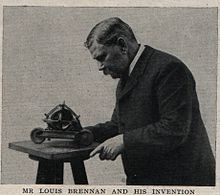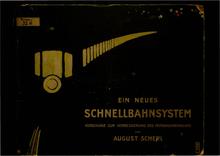Monorail to Louis Brennan
In 1907 the Irish-Australian engineer Louis Brennan developed a gyro-stabilized monorail in which the vehicle ran on steel wheels with double flanges on a single Vignole rail .
technology
The technical structure is described as follows:
- In the Brennan car, a DC drive machine drives two jackshafts through gear wheels , each jackshaft is connected to an inner axle of one of the two-axle bogies by means of a crank and counterweighed coupling rod . The pivot allows rotations about the vertical and the horizontal transverse axis, but not about the horizontal longitudinal axis.
- The gyroscope with horizontal transverse rotation and vertical adjustment axis carry the armatures for shunted engines, the gyro housing the armature bearings with white metal, oil circulation under pressure and cooling. The car ran on a slope of 77 ‰. The petroleum motor, the power generator and the gyroscope, together with the adjustment, are housed in a booth on one end of the otherwise open car.
The same source describes the modified variant according to Scherl:
- In the Scherl car, an inner axle of each of the two two-axle bogies carries a driving machine. Power is supplied by a scissor roller pickup made of copper cables next to the rail. Originally, the swirl of both gyroscopes together required 37 hp. After the air was enveloped and sucked out of the housing, the resistance of each gyroscope dropped to 0.37 hp.
- One drive switch operates all machines. The housings of the vertically positioned gyroscopes under the seats are coupled to the horizontal, transverse adjustment axes using cranks, push rods, angle levers and toothed arches so that the two gyroscopes must be adjusted in exactly the opposite direction. The additional adjustment is carried out by an oil pump and a »servo motor«, which responds under oil pressure without a dead gear and accelerates the adjustment as soon as the tilting of the car initiates an adjustment. The artificial adjustment is a fraction of the natural one and is in direct proportion to it.
In the illustration of the monorail car, modified according to Scherl's plans, with two rows of seats in the middle, the letters drawn mean:
|
Applications
A first model was made on a reduced scale and presented to the public on November 10, 1909 in the exhibition halls at Berlin Zoo . Brennan also presented his test car in Gillingham , England in 1909 . In 1910, a full-size demonstration facility was built in White City, London , and Brennan's car was shown in operation at an exhibition in 1910.
In 1909, the Berlin publisher August Scherl propagated the gyro-stabilized monorail in an advertising leaflet entitled “A new rapid transit system” as a means of transport for local and long-distance traffic of the future that would soon span all of Europe.
Scherl, together with the district administrator of the Obertaunus district , Ritter von Marx , campaigned for an application in Germany with the project of a monorail on the edge of the Taunus . Von Marx visited the test facility in England in 1911 and reported:
“The impressions that I received there - as a layperson, of course - of the system were above expectations. The car, which can hold around 40 people, is easily cranked like a car. He stands - what I initially thought was the most unlikely - without any aids and without any sway, with any weight shift by boarding and moving passengers in a standing position, starts with the greatest ease, forwards and backwards, takes a circle of 105 feet [32 m] radius with a speed of up to 70 hours-kilometers, holds at will even in the very sharp bend and stands just as still and safely even after the engine is switched off - as I was assured for about 4 hours, i. H. as long as the tops are running. Its gait is naturally much quieter than that of a two-rail railway. For an hour I drove back and forth on the track, which is only about 200 meters long, of course, and in the narrow circle, and it worked perfectly. "
However, this project was canceled before a final decision was made and there were no other projects.
From 1921 to 1922, Pyotr Petrovich Schilowski tried to develop a similar single-track railway , for which an 11 km long test route between Saint Petersburg and what was then Detskoye Selo was built. Technical problems and lack of money ended the project.
Individual evidence
- ↑ zeno.org Roell, Encyclopedia of Railways, edition 1912–1923, text in the public domain
- ↑ douglas-self.com



